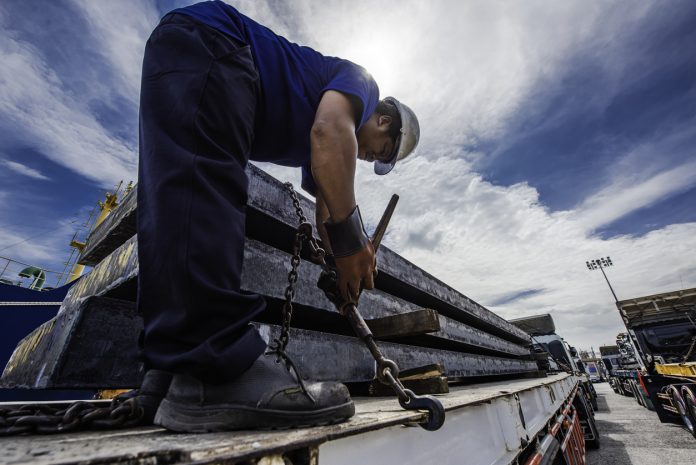
Securing loads to a flat deck using chains is quite different than straps. Some of the rules are the same, but not all. Straps are “indirect securement”, meaning they hold the freight to the trailer. Chains are “direct securement”, meaning they attach the freight to the trailer. The difference being, with enough force, freight could slide out from under straps. Chains are attached to both the freight and the trailer, meaning that the freight can’t slide out at all.
For this example, let’s assume we’re loading a 30,000 lbs bucket loader, like you see in construction sites. Chains have a WLL (working load limit) of 5,000 lbs, so for 30,000, we need 6 chains minimum. Our bucket loader, like most such equipment will have clearly identified securement points near the front and rear corners. For maximum security, whenever possible cross chain the corners. Attach the chain to the left side of the machine, going through the securement hole, and put the hook onto the chain. and the other end to the right side of the trailer, passing the chain between the deck and the rub rail and secure the hook back into the chain. Have the front and rear chains pulling in opposite directions. The chains on the back pulling forward, and the front chains pulling back, as if you’re trying to squeeze the loader. Or you can have the rear chains pulling back and the front chains pulling forward. Either is acceptable. Once the 4 corner chains are in place, take up as much slack in the chain as you can, then use the binder to tighten the chains as much as possible, again, keeping the bar between you and the load. Once the binder is closed, use bailing wire, or a similar item to bind the handle of the binder closed to keep it from popping open. A bungee cord is NOT acceptable for this purpose. You can use a bungee cord to secure the excess chain to prevent it from falling off the trailer, though.
Once these 4 chains are in place, you will need to add 2 more somewhere in the center of the machine, again, crossing the chains. Once all 6 chains are in place and tightened down, make certain no chain is rubbing against another chain. Placing carpet between the chains will prevent the chains from rubbing. Now you need a strap to hold the bucket (or forks) from bouncing around. Use edge protectors or carpet to keep the edge of the bucket from cutting the strap, and tighten it down as well.
It is very important that you stop at least every 2 hours to check the tightness of the chains. They do tend to loosen up, especially if they have a slight twist in them.


















